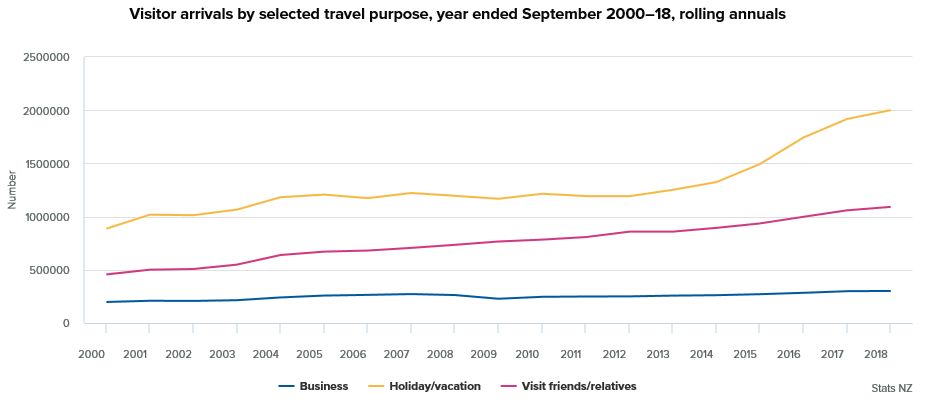Net migration is lowest since 2015 – 22 November 2018
Annual net migration has eased to its lowest level in three years, Stats NZ said today. For the year ended October 2018, it fell to 61,800.
Net migration for the October 2018 month was 6,700, down 1,000 from October 2017.
Overall, net migration was down 8,900 from the October 2017 year, reflecting both fewer migrants arriving in New Zealand and more leaving the country.
For the October 2018 year compared with the October 2017 year:
- migrant arrivals were 128,100, down 3,500
- migrant departures were 66,400, up 5,400.

“Although migrant departures continue to be the driving force behind falling annual net migration, October also had a noticeable fall in the number of migrant arrivals,” population insights senior manager Brooke Theyers said.
“Both trends helped bring annual net migration to its lowest level since the year ended September 2015.”

Text alternative for Permanent and long-term migration, year ended October 2018.
Departures for non-New Zealand citizens were 31,800, up 4,400 for the year. Arrivals for non-New Zealand citizens dropped to 96,700, down 2,800. More New Zealand citizens left the country long-term than returned after living overseas for more than a year – leading to a net loss of 3,100 New Zealand citizens in the 12 months.
Departure cards are gone
From 5 November 2018, travellers leaving New Zealand no longer need to complete a passenger departure card. This change affects the release of travel and migration statistics in several ways.
New release schedule
Removing departure cards means changes to the timing and composition of this release. Statistics on short-term movements (including the current report International visitor arrivals to New Zealand) will be published in a new International travel release, and long-term movements in a new International migration release.
Both releases will be published on the same day, up to 30 working days after each reference month. November data, previously published just before Christmas, will now be published in January, and December data in February.
Release calendar
The new release schedule largely reflects the need to use the Integrated Data Infrastructure to provide place-of-residence in New Zealand for migrants and short-term resident travellers. This replaces information from the departure card. The timing is also affected by the new method to produce ‘provisional’ migration estimates.
Migration estimates
The release in January will fully adopt the outcomes-based measure of migration, first released in May 2017. This measure looks at the travel history of a passenger over a 16-month follow-up period, and classifies a border-crossing according to how long they spent in New Zealand rather than relying on the stated intention on the passenger cards.
Update on the development of provisional external migration estimates
‘Provisional’ migration estimates are a timely measure of migration; they are revised each month until they are finalised after 16 months. Further updates about provisional estimation are planned for late November and December 2018.
‘Final’ migration estimates, based on the ‘12/16-month rule’ and released today on Infoshare, are now updated to June 2017.
Outcomes versus intentions: Measuring migration based on travel histories explains more on the new approach.
More information
See Migration Data Transformation
Text alternative for Permanent and long-term migration, year ended October 2018
Diagram shows arrivals of non-NZ citizens were 96,700, down 2.8 percent; departures were 31,800, up 16.1 percent; this made a net migration gain of 64,900 non-NZ citizens.
Arrivals of NZ citizens were 31,400, down 2.2 percent; departures were 34,600, up 3.0 percent; this made a net migration loss of 3,100 NZ citizens.
Result is a total net migration gain of 61,800.
Note: Figures may not sum to totals due to rounding. Percentage changes are indicative of the October 2018 year compared with the October 2017 year.
For more information about these statistics:






















